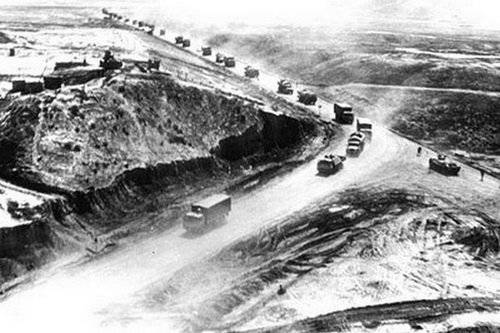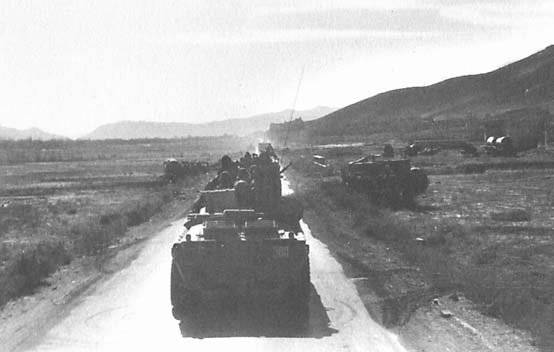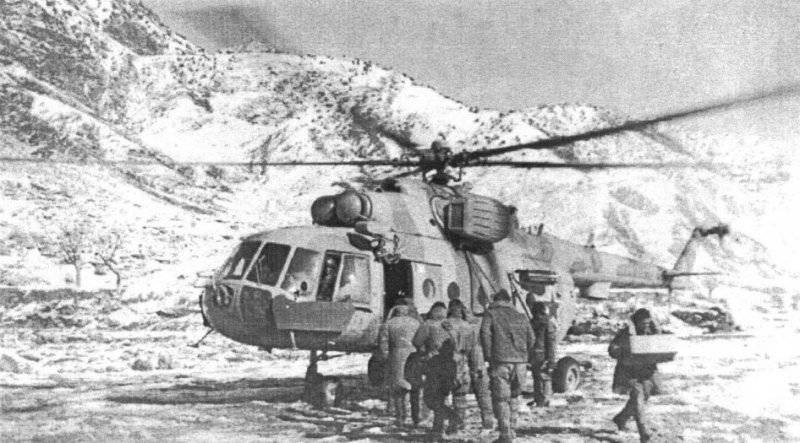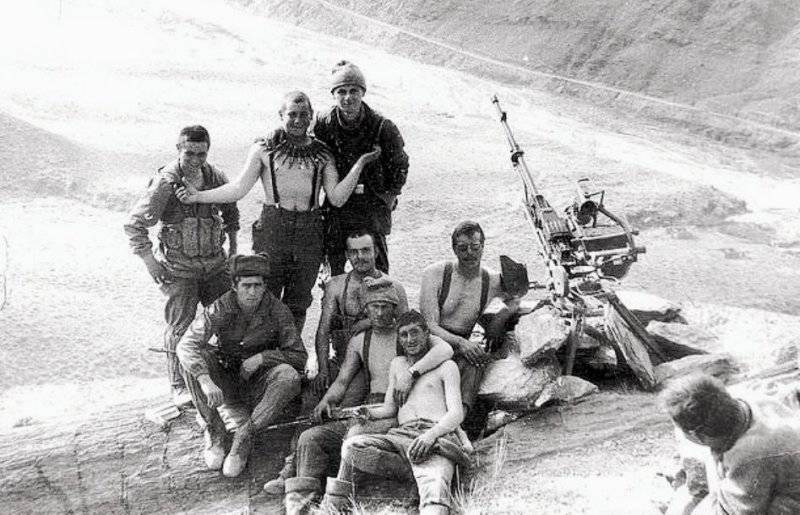9-i company. Operation Highway
 33 passed the year as Soviet troops entered the territory of Afghanistan. The time has come to understand the outcome of the participation of the Soviet military contingent in the Afghan civil war.
33 passed the year as Soviet troops entered the territory of Afghanistan. The time has come to understand the outcome of the participation of the Soviet military contingent in the Afghan civil war.Afghanistan is located in the center of the Eurasian region and has always been interesting to American geopolitics, as an unstable region located near the Soviet borders.
The civil war was the result of the opposition of the leadership of Afghanistan, who tried to carry out reforms to bring the country to a new level of development, and the Islamic opposition, which was supported by the Mujahideen, part of the Afghan population and a number of countries of the Islamic world.
The Soviet Union has repeatedly rejected requests from the Afghan leadership to provide military support in the fight against the militarized units of the Islamic opposition. But in March, 1979, a so-called Herat revolt took place in Afghanistan: anti-government groups supported by the Afghan army launched an offensive against the government of the country with the slogan “Islamic revolution without Soviets and the West”. The insurgency became a catalyst for many uprisings that swept across Afghanistan. The Soviet leadership saw this as a threat to the security of the USSR and decided to take measures to strengthen the Russian border with Afghanistan and prepare for the introduction of Soviet troops into Afghan territory. In December 1979, a contingent of troops was deployed to Afghanistan by order of Defense Minister D.F. Ustinov.
The main tasks of the Soviet troops were aviation, artillery, sapper support for the Afghan troops, as well as the suppression of the supply of arms to the opposition troops from abroad.
In 1982, the leaders of the Mujahideen under the patronage of Pakistan created an alliance called the Alliance of Seven, which set as its goal the creation of an Islamic state in Afghanistan. And for this they decided to create an alternative government. The city of Khost was well suited for the role of the capital of “free Afghanistan”. This city is located on the border with Pakistan in remote mountains. From it from the center of the country one single road led through the Seti-Kandav pass. Therefore, the one who owns this pass, he controls the entire province of Khost. The main population of the province are nomadic tribes, the warriors of which are distinguished by their aggressiveness and good military training.
The Mujahideen built a Jawar stronghold in Khost province, which was a fortified base and a transit point for militants. Through it, up to 20% of deliveries of weapons, equipment and ammunition from Pakistan were carried out.
Soviet troops exercised control over the supply weapons and equipment on the roads leading from Khost to the central part of the country. The Soviet units were not part of the lair of the Mujahideen.
But the Afghan government, realizing the importance of having oppositional power, repeatedly took measures to destroy the Jawar base, but to no avail. The militants, capturing the Seti-Kandav pass and, creating an irresistible bastion there, formed a powerful Host fortified area called Srana. To destroy this fortified area, the Afghan leadership has repeatedly appealed to the Soviet government to assist in the liberation of Khost province from the Mujahideen. Gorbachev, knowing full well what losses the Soviet military contingent may incur in carrying out this military operation, nevertheless, gives this order.
Despite receiving instructions to provide military support to the Afghan army to unlock Khost, the military command of the Soviet group took steps to resolve this problem peacefully. Repeatedly, Gromov, commander of the 40 Army, tried to meet with the leaders of the Mujahideen, but to no avail. There was only one possible way to fulfill the order of the supreme commander-in-chief - to storm the pass and break through with the battle at Khost.
The operation to seize the militants' fortified area was code-named “Highway”. Twenty thousand mojaheds opposed the twenty-thousandth group of Soviet and Afghan troops. Planning and preparation for the largest-scale operation was carried out with the utmost secrecy. Even the leadership in Moscow was not dedicated to its details.
The special operation began with the landing of the landing over the Seti-Kandav pass. The militants opened heavy fire with all types of available weapons on paratroopers descending on parachutes. Meanwhile, reconnaissance aircraft, which accurately spotted all the firing points of the militants, flew near the transport workers. By a joint strike by artillery and aviation, skillfully adjusted by the observers, all the firing points of the Mujahideen were destroyed and, having risen to the height of motorized riflemen, Setiandav pass met with complete silence. In this battle, not a single soldier was killed, because military ingenuity was used - instead of real paratroopers, they dropped mannequins made of overalls, stones and rags instead of real paratroopers. The successful seizure of the pass was achieved thanks to the talent and professionalism of the command and rank and file structure of the Soviet-Afghan military formation.
Taking the pass allowed, under the cover of the airborne unit, to begin the transfer of special military units, equipment and food to Khost, as well as to carry out a sweep from the dushmans of the Srana fortified area.
The fighters of the elite unit of the Mujahideen "Black Storks" made a desperate attempt to break out of the encirclement and, if luck was on their side, seize control of the only road to the base Javar. This unit was created by the secret services of Pakistan. It consisted of both Afghan militants and mercenaries from different countries of the world (Jordan, Iran, Egypt, Saudi Arabia, Pakistan, and the PRC). The “Black Stork” fighters were professionally trained: they owned all types of weapons and communications equipment, the ability to make non-standard decisions. The main location of the “black storks” was inaccessible high-altitude areas near the borders with Pakistan. Chernoaistniki participated in the organization of ambushes on military units of the Soviet troops. The name of the unit corresponded to the color of the clothes worn by the militants. They were all followers of radical Islam. In a fight, any fighter of this special unit could take unjustified actions (become full-length and open fire on the enemy, read during the battle through the loudspeaker of the sura from the book "Storks"). They believed that this could break the morale of the Soviet soldiers.
On their way there were fighters of the 9th Airborne Company - 39 people. The paratroopers occupied a fairly successful position at the height of 3234. Dushmans had a numerical superiority - according to available information, there were about 400 people.
At the beginning of the battle, the position of the fighters of the 9 Company was subjected to the most severe shelling from guns, mortars, grenade launchers, rockets. Using the folds of the terrain, the black iron came to the positions of the paratroopers at a distance of 200 meters. With the onset of dusk, they rushed from all sides to attack.
Loss of dushmans amounted to: 15 killed and 30 injured. In the reflection of the next assault, the junior sergeant V. Aleksandrov died. His colleagues said that the black-shirts, brutal from their failure, launched an attack on the paratroopers' position in full growth. This allowed Slava Alexandrov to conduct aimed fire from a machine gun. Even when the machine gun failed, he accurately sent five grenades into the target, and then fired at the Mujahideen from a machine gun. When changing positions, he was seriously wounded and died in the hands of his comrades.
 At night, spooks went to the next attack: they were not even stopped by a minefield - they literally walked over the corpses of their co-religionists and they managed to get closer to the positions of the paratroopers at a distance less than 50 meters. The soldiers under the command of Sergeant A. Kuznetsov, despite the numerous wounds received, repulsed the attack, but the sergeant himself was killed.
At night, spooks went to the next attack: they were not even stopped by a minefield - they literally walked over the corpses of their co-religionists and they managed to get closer to the positions of the paratroopers at a distance less than 50 meters. The soldiers under the command of Sergeant A. Kuznetsov, despite the numerous wounds received, repulsed the attack, but the sergeant himself was killed.At the most intense moment of the battle, a reconnaissance platoon came to the aid of the paratroopers and delivered ammunition to the positions. At this time, the defenders had only one magazine of ammunition left and grenades were completely absent.
A special role in repelling the onslaught of black-shirts was played by artillery. The spotter Ivan Babenko skillfully corrected artillery fire, and at critical moments caused fire at a close distance from the position of the company. Precise strikes of guns cut off the attacking dushmans from the location of the paratroopers.
The fighters of the 9 Company over a twelve-hour battle repulsed all the attacks of the Black Storks and forced them to retreat. After the end of the battle, the defenders of the height saw abandoned guns around the position, a large number of machine guns, as well as foreign-made grenade launchers and small arms.
Operation Highway should be included in textbooks on military strategy and tactics as the most successful battle conducted by the Soviet command in Afghanistan. But, unfortunately, this victory was practically stolen from the officers and fighters - in the information spread by the media, this operation and the feat of the paratroopers were called a carnage.
The new generation of Russia should remember the young guys who have fulfilled their military duty to the end: Vladimir Krishtopenko, Andrei Melnikov, Andrei Tsvetkov, Andrei Fedotov, Anatoly Kuznetsov and Vyacheslav Aleksandrov.
And although much is becoming known about the war in Afghanistan, so far many events have not received their real assessment.
But even on the basis of the available information, it can be reasonably assumed that this was a successfully planned and organized strategic operation, which had the goal of destroying the socialist bloc and the Soviet Union. This war showed all the inconsistency of the solution of political problems by force. This conclusion is especially relevant now, when joint resolutions on the forceful resolution of regional conflicts are adopted under the auspices of international forums and organizations.
Part of the documentary (the beginning unfortunately has not survived) M. Leshchinsky - Operation Mainline.
Participants of the operation (45 ISP, 345 regiment (in particular 9-i company) and many others) is dedicated.


Information